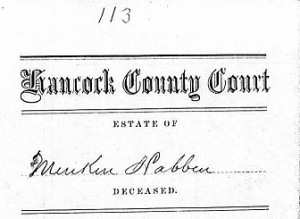 I’m not really certain that I’m happy with it, but I’ve settled on a working citation for probate materials from Ancestry.com collection. My concern was that I needed to indicate the:
I’m not really certain that I’m happy with it, but I’ve settled on a working citation for probate materials from Ancestry.com collection. My concern was that I needed to indicate the:
- original creator of the material
- the site where the records were accessed
- Because Ancestry.com has so much material and so many databases, I used the title of the database from which the probate imges were pulled. I don’t do this for the US federal census because I’ve never done it and locating the census images is relatively easy on Ancestry.com. There are some states for which Ancestry.com has several probate databases and the title makes the Ancestry.com location of the material easier.
- and, because the site holding these records did not make the images from the actual records, I need to indicate who actually copied the actual records–the Family History Library
I ended up with the item shown below–hopefully in the spirit of Evidence Explained. I spent far too much time concerning myself with where to place the title of the database.
Hancock County, Illinois, Probate Court Files, Box 113, Estate of Mimken Habben, Petition of Antie Habben to be Appointed Administratrix with the Will Annexed, 26 March 1877; Ancestry.com, “Illinois, Wills and Probate Records, 1772-1999” (http://www.ancestry.com : accessed 3 January 2016), citing FHL microfilm publication 1547540.
I’m open to suggestions. This seemed to fit my purpose for the time being. Note: I had a suggestion from a respected colleague that there does not need to be a comma before the parenthesis in this citation. It has been removed because my graciously was spot on.
This item is one that is analyzed in the next issue of Casefile Clues.

4 Responses
The format in your example is exactly how I do it as well. But being the obsessive/compulsive documentation freak that I am, I probably would have transcribed the entire document word for word as well. I know, I know..it’s a sickness. 🙂
I’m having trouble trying to create the citation for a will found on FamilySearch.org, (not the original but from a bound will book in the court house). I, too, am spending way too much time on this!
Who “copied the actual records”?
The FHL is the repository from which Ancestry got a copy of the microfilm, but the microfilm copy was probably done by the Genealogical Society of Utah. You can usually find this out from the source and production detail cards at the beginning of the microfilm roll.
But some databases have been digitized directly from records, and sometimes the microfilm was supplied by a State or local agency. It’s always useful to take a look.
You’re right that the FHL is the repository and that the filming was actually done by the Genealogical Society of Utah. Ancestry.com in some cases doesn’t include the production detail cards which makes determining the film roll a little difficult and in some cases makes it really hard to tell where the original was obtained. Usually going to the first image will answer this questions as the cards are there (like they are at the front of the film), but sometimes they didn’t include images of those cards.
But you are right that it’s always worth a look.